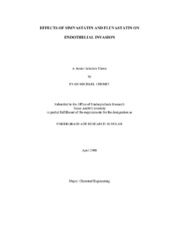| dc.description.abstract | Endothelial invasion is a crucial step in angiogenic blood vessel formation and has ramifications in wound healing, tumor growth, and may have implications in heart disease. During invasion quiescent endothelial cells (ECs) proteolyze their basement membrane, proliferate, and sprout into the extracellular matrix. This process is partially mediated by contact feedback from integrins and stimulated by angiogenic growth factors Vascular Endothelial Growth Factor (VEGF) and basic Fibroblast Growth Factor (bFGF), as well as the lysosphingolipid Sphingosine-1-Phosphate (S1P). Invasion is distinguishable by dramatic EC morphological changes from simple squamous cells to sprouting structures that ultimately form new lumens.
Cholesterol synthesis is inhibited by a class of drugs called HMG-CoA Reductase inhibitors, also known as statins. Statins are the first line of pharmacological treatment for reducing cholesterol levels when diet and lifestyle changes are not sufficient. 3-hydroxy-3-methylglutaryl-CoenzymeA (HMG-CoA) Reductase is the key rate-determining enzyme of the mevalonate pathway, the biological process by which dimethylallyl pyrophosphate and isopentyl pyrophosphate (sterol precursors) are synthesized. Statins are effective in reducing the risk of atherosclerosis, a major cause of cardiovascular disease and studies have shown that statins may have secondary protective effects.
In our study, we tested the effects of statins on endothelial cell invasion. To investigate the effects of statins on endothelial function, we studied the effects of two different statins on regulating endothelial invasion of three-dimensional collagen matrices. The natural product-derived Simvastatin (ZOCOR®) and the synthetic Fluvastatin (LESCOL®) both lowered cellular cholesterol levels and inhibited invasion. Both were tested at concentrations within the range of human plasma levels and in the presence of S1P, VEGF, and FGF. Differences in the known signaling proteins Erk 1/2, Akt, and Paxillin were analyzed by gel electrophoresis and western blotting. | en |


